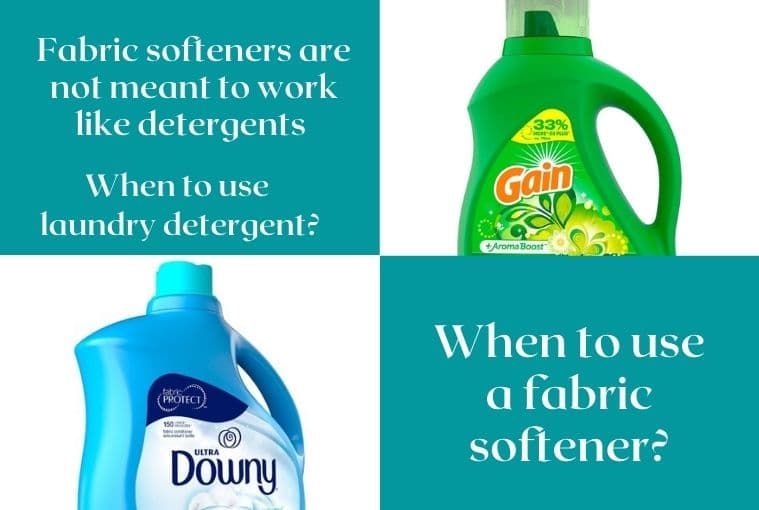Have you ever accidentally bought fabric softener thinking it was detergent and washed your clothes with it? I have. And although the clothes seemed clean and smelled fresh, the more pressing question was if the clothes were actually clean.
I am sure you have wondered the same. Let me answer some of your questions and tell you why you should never make that mistake.
Fabric softener Vs laundry detergent
Fabric softeners are not meant to work like detergents
Detergent works on clothes like shampoo works on your hair. Like shampoo, detergent removes all the dirt and sweat from your clothes.
After your clothes are clean, you are left with a coarse fabric. Like your hair, your clothes need a conditioner to soften your fabric. This is why you should use fabric softener after washing your clothes.
The reason you don’t want to just use a fabric softener is that although your clothes might look clean and feel fresh, they’re not actually clean. Fabric softeners are meant for making the clothes feel clean and fresh, while detergent actually cleans them by removing all the dirt and sweat.
Detergent is essential fabric softener is not
To get clean clothes, laundry detergent is a must. Fabric softeners, however, are good to have but not essential.
Add fabric softener to a wash when it is on the rinse cycle. This will soften the coarse fabric and make it feel soft against your skin.
When to use laundry detergent?
Use laundry detergent in every wash to get clean clothes. Do not substitute the detergent with a fabric softener. Fabric softener lacks the essential cleaning agents and enzymes that dissolve the dirt and stains from the clothes.
Although there are some alternatives to store-bought laundry detergent like borax and baking soda, laundry detergent is definitely more convenient.
The only choice you have to make is the kind of laundry detergent you want to use. Some brands of detergent are made for delicate clothing, while others are made for tough stains.
When to use a fabric softener?
Washing machines clean your clothes by agitating them and using friction. This can damage the fibers which can leave the fabric coarse. The softener protects those fibers by reducing friction. This is why you add the softener to smooth out the fibers to make your clothing soft and more comfortable against the skin.
Because the fibers are softened, instead of rubbing against each other the clothes just glide side by side. This prevents the fibers from getting damaged and hence, your clothes not only feel softer but last longer.
If you aren’t fascinated by the idea of perfumes, but still want your laundry to have a pleasant fragrance. Using a fabric softener is an easy way to add a splash of fragrance to your laundry. Your clothes will smell pleasant for days.
Fabric softeners can also prevent your clothes from fading. The colors will be protected for longer due to the fibers in the fabric remaining soft. This softness assists the fibers in retaining their absorption levels, as well as retaining their color.
Fabric softener will work best used on your cotton, wool, and linen fabrics. Because these fibers are natural they can easily become rough in the wash.

When to not use a fabric softener?
There are some fabrics on which you don’t want to use fabric softeners.
Microfiber fabric is designed to trap dust, dirt, and perspiration. If you add fabric softener to this fabric, it will clog the spaces in the fabric that are designed to grab the dust.
Like microfiber fabric, moisture-wicking clothing also has gaps. These gaps are placed between the fibers to prevent perspiration. Fabric softener can clog the gaps and prevent moisture from escaping.
Your first instinct might be to use the softener on your fleece and fluffy clothes to keep them soft. However, softener attaches to fibers and can drag them down, making your fluffy clothes hard and rough.
Never use fabric softener on baby clothes. Babies have sensitive skin and the chemicals in the softener can be harsh on it. Baby clothing is also treated so it can be flame resistant. Fabric conditioners can endanger babies as it strips the flame retardant coating.
A towel’s main function is to be super absorbent so that it can dry your skin. Softeners coat the surface of the towel fabric. This prevents the fabric from absorbing your body’s moisture.
Add fabric softeners to wash or dilute it. If you apply it to clothes directly, the fibers of your garment will get damaged.
Key Ingredients of a laundry detergent
Understanding the key ingredients and their function will help you pick the brand that is best for your needs. For example, if your water is too hard, you need a detergent with water conditioners and pH modifiers.
Alkalis are soluble salts. They can dissolve fats, oils and grease. This is why laundry detergent can remove stains without rubbing. The most common alkalis found in detergent are caustic soda and potassium hydroxide.
Laundry detergent should also contain sulfate. Sulfate acts as a cleaning agent. It is also used in soaps as it is good at removing oil and dirt because it reduces the surface tension of a liquid.
Enzymes are present in all our stomachs and it should be in your laundry detergent too. In our washing machines enzymes act as waste-disposal units and accelerate the removal of dirt.
Preservatives are also added to keep the enzymes effective for longer. Water conditioners and pH modifiers soften the water and protect your clothes from hard water damage. Hard water can cause detergent stains on your clothes.
Key Ingredients of a fabric softener
The conditioning agent in the softener is a combination of oils and lubricants that coat the fabric. This bonds to the negative fibers and neutralizes them. This reduces electrical build-up caused by friction and prevents static cling in your clothes.
Emulsifiers encourage one liquid to be held within another. Fabric softeners can contain three different types of emulsifiers. These three emulsifiers help the conditioning agent of the softener attach to the fabric and to do its work.
Softeners also have preservatives. This allows you to shelf the bottle and use it for weeks as per your need.
Fabric conditioners contain fragrance to overpower the nasty odors left over from the washing cycle. However, this fragrance can be overwhelming at times. You can pick fragrance-free options.
How to use a fabric softener?
If you’ve not used fabric softener before, and feel unsure about the process then don’t worry. We have all been there.
Laundry detergent and softener are also sold in a combined form, so you don’t have to buy them separately. You also get rid of the hassle of adding the softeners after the detergent as it will be released automatically.
Do not mix laundry detergent and fabric softener together at home. The detergent will prevent the softener from working. The store-bought two-in-one products separate the softeners from the detergent with a membrane so that the softener is released at the appropriate time.
Add detergent and softener, separately in the dispenser. The dispenser will automatically release the softener during the cycle.
I used fabric Softener to wash my clothes, what do I do?
You have no reason to panic. The softener will not ruin your clothes. Let the wash continue until the end and remove the clothing.
Re-wash your clothing using detergent. The detergent will remove the softener from the clothes. After this, you can add the fabric conditioner during the cycle.
I used fabric softener on a fabric that I wasn’t supposed to, what do I do?
Trust me; been there, done that. It is not likely that just one wash with a fabric softener ruined your clothing. However, you can still remove the fabric softener from your clothing.
Rewash the clothing with detergent to remove the softener. The water level should completely cover the item. Rewash the clothing till all the conditioner is gone.
When fabric softener is used the way it was intended, it can make a real difference to your clothing. It may take you a few tries to get a hold of the process but including this step in your laundry routine will pay off. Your clothes will last longer and look brighter.









Leave a Reply
View Comments